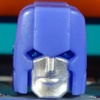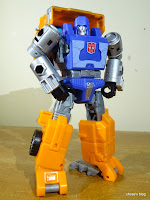Rocket League has a simple premise, you control rocket powered vehicles in order to play a game of soccer. This simple to pick up but filled with nuance game has skyrocketed to popularity, spawning e-sports tournaments as well as going free-to-play on all platforms. The controls are very easy. You control a vehicle with typical driving controls that allow you to go forwards and backwards. Your vehicle can perform a double jump and scattered around each arena are boost pads which refills your boost meter. This allows the vehicle to boost in speed (and strategic usage of it will effectively allow your vehicle to fly for short periods of time over a long distance). Boost into an opponent’s car and you will destroy them, forcing them to respawn. In an effort to not hinder the pacing of matches, your car won’t stop when hitting against a wall, instead, you can drive on walls and even parts of the ceiling.
The objective of each match is basic; you try and score as many goals by hitting the ball into your opponent’s goal. While there are various arenas, each one has the exact same layout, with just a different skin on top. The ball is oversized and physics come into play in how you angle and hit the ball. Hit the ball head on using a boost will make it fly, while doing a side flip against the ball will knock it slower into another direction.
What makes things difficult when you first start the game is that the ball bounces, affecting your timing. You will either wait for the ball to hit the ground before running up to it or miss it completely as you misjudge the height. This is where the skill different comes into play. Beginners will play games with the ball mostly on the ground but watch games of higher skilled players and you can see that they play with the ball mostly in the air. It’s really impressive and something to aspire to (hopefully) with practice. This is where the gameplay truly shines at how different it plays once you gain experience, given its simple controls and premise.
The game controls very smoothly. The vehicles move as you’d expect it to and it instantly feels natural. There is an arrow that points to where the ball is at all times or you can press a button that will cause the camera to track the ball. The controls and settings are incredibly customizable; you can play around with things like the field of view, controller dead zones and camera speed. You can remap the controls to whichever buttons you want as well as change the parameters of the gameplay itself. For example, you can increase the speed of the ball, change the ball physics and bounciness, match length, vehicle boost time and more.
This is primarily a multiplayer game but there is still a meaty single player portion. Naturally, there are a variety of tutorials and practice arenas to get you up to speed. Once you’re comfortable, then you can play the Seasons mode, which basically pits you against bots as you play multiple games in a season ranging from a 9 week season season a 52 week season. You can create your own custom private matches as well as local multiplayer and fill it with bots of varying difficulty.
However, the multiplayer aspect is really where it is at. This is where teamwork comes into play a lot more as well given that you cannot just mindlessly go after the ball. You need some sort of strategy to not allow holes in your defense and it is really interesting to see how it has developed and well understood throughout the online community. The game is cross-play too so it is never hard to find a game.
There are a variety of modes. The standard is a 3 vs 3 match that lasts for five minutes. These quick matches are fun and don’t drag on for too long before you move onwards. The replay cams whenever someone scores a goal are fun to watch, given that the ball explodes and pushes all players away (with the option of customizing the type of explosion effect as well). In addition to that, there is a 1 vs 1 and 2 vs 2 mode which is much more reliant on a single player’s skill, as well as the 4 vs 4 mode which is way more chaotic. If you’re tied after the five minutes are up, it goes into overtime (sudden death) where the next goal will win the game.
The additional modes include Hoops, which is a version that instead of scoring goals like soccer, you hit the ball through hoops like basketball. Snow Day replaces the ball with a hockey puck set in a snowy arena. Rumble mode adds in power picks up akin to Mario Kart that replenish on a ten second cooldown system. Dropshot doesn’t have a net to score goals in. Instead, you hit the ball in order to light up the ground and eventually break it to shoot the ball through to score. Heatseeker is weird in that the ball is attracted to the goal so you score goals really quickly… but drags out the match and makes it boring since it is one or two hits before you score a goal.
With the game being free-to-play, there are attempts to monetize the game. However, all the purchase options are cosmetic. If you stick to being only a free player, you can still unlock plenty of cosmetics via completing challenges; it just takes a bit longer. There are also seasonal events for the online portion where you gain experience and rank up.
Overall, Rocket League is surprising at how deep the gameplay can get considering on the surface, it seems so simple. the controls feel great and the fact that you can easily pick up to start playing is a major plus. Once you start playing through a few games and gain experience, it’s a blast to see yourself improve over time. Furthermore, the feeling that you get when making a great shot or save is unparalleled.
--------------------------------------------------
For other game reviews, have a look at this page.

























































